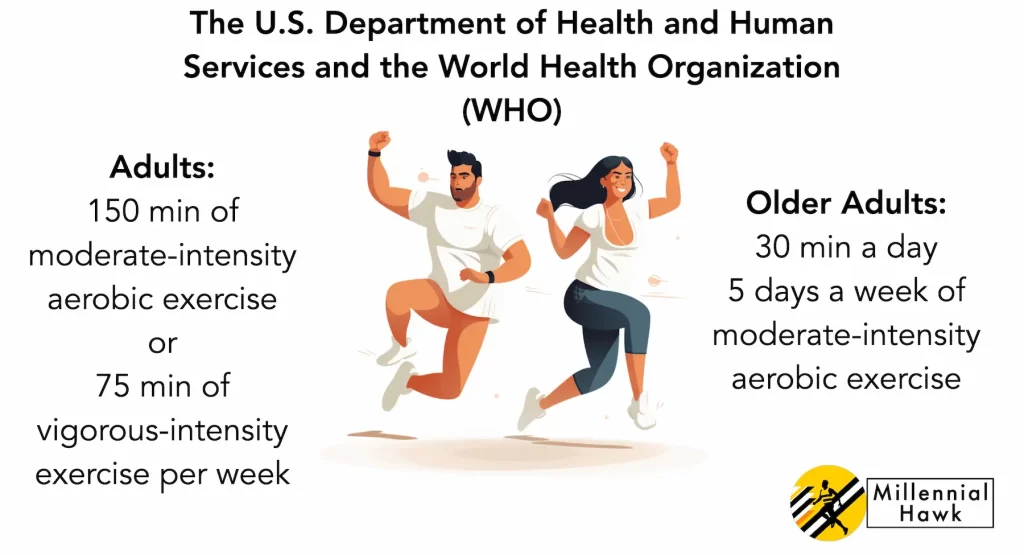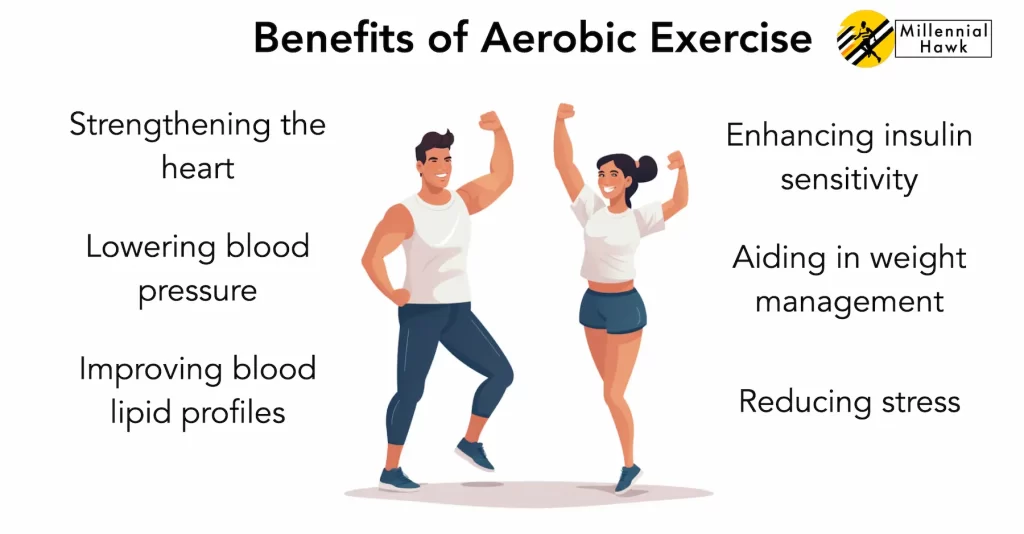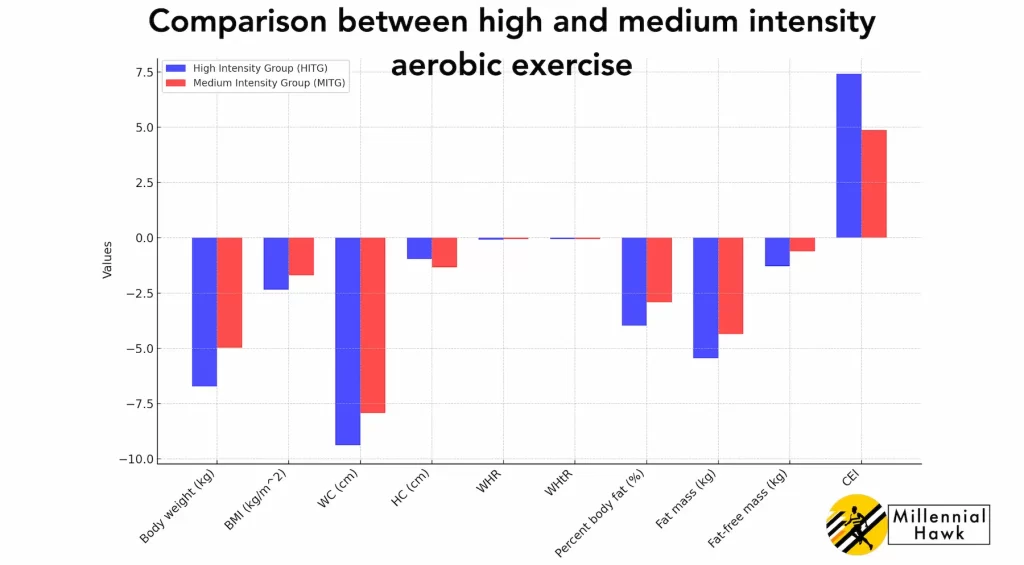Cardio exercise, also known as aerobic exercise, refers to activities that increase the heart rate and breathing rate, promoting cardiovascular fitness. It involves continuous rhythmic movements that engage large muscle groups over an extended period.
The primary focus of aerobic exercise, as described in a 2013 study by Marco Y C Pang from The Hong Kong Polytechnic University, is to improve the body’s capacity to efficiently transport oxygen and nutrients to the muscles, while also removing waste products.
Examples of cardio exercises include running, jogging, cycling, swimming, dancing, and brisk walking. These activities can be performed at various intensity levels, such as low, moderate, or high intensity, depending on the individual’s fitness level and goals.
Aerobic exercise is beneficial for improving cardiovascular health, increasing aerobic capacity, burning calories, and aiding in weight management. It can also contribute to reducing the risk of chronic conditions, such as heart disease, stroke, type 2 diabetes, and certain types of cancer. Additionally, cardio exercise has been shown to improve mental health, enhance mood, reduce stress levels, and improve overall quality of life.
This article explores the benefits of aerobic exercise based on its intensity, its potential disadvantages, the recommended amount of aerobic exercise per week, and how to integrate it into your cardio workout routine.
What is the definition of aerobic exercise?
Aerobic exercise, also known as cardiovascular exercise, is defined by a 2016 study by Ahad Wahid from the University of Oxford & Oxford Clinical Academic Graduate School as physical activity that stimulates and strengthens the cardiovascular system by increasing the heart rate and breathing rate.
The American College of Sports Medicine (ACSM) defines aerobic exercise as any activity that uses large muscle groups is maintainable continuously, and has a rhythmic nature. Cleveland Clinic further defines aerobic exercise as any physical activity that expends energy and is typically undertaken to boost health and fitness, maintain an ideal weight, or elevate physical performance.
What is the definition of ‘aerobic exercise’ in the dictionary?
The dictionary defines “aerobic exercise” as the type of repetitive, structured physical activity that requires the body’s metabolic system to use oxygen to produce energy. This form of exercise improves the capacity of the cardiovascular system to uptake and transport oxygen.
It can be undertaken in various forms, but the commonality is that it is performed at a heart rate of 70–80% of a person’s age-appropriate maximum. Aerobic exercise is a fundamental component of endurance training, marked by moderate energy expenditure over an extended duration. One measure of aerobic power or endurance is VO2 max, which denotes a person’s maximal oxygen uptake.
What is the difference between aerobic and anaerobic exercise?
The fundamental difference between aerobic and anaerobic exercise lies in the way they produce energy. Aerobic exercise relies on aerobic metabolism, which requires oxygen to create ATP (adenosine triphosphate), the energy currency of the body. This type of exercise is characterized by long-duration and low to moderate-intensity activities, such as jogging, swimming, and cycling.
On the other hand, anaerobic exercise does not rely on oxygen for ATP production. Instead, it utilizes energy sources within the muscles themselves through glycolysis and fermentation, resulting in the production of less ATP and the accumulation of lactic acid. Anaerobic exercise is characterized by short bursts of high-intensity activity, such as sprinting and power-lifting.
Which should be done more frequently in a workout routine?
The frequency with which one incorporates aerobic and anaerobic exercises into a cardio workout routine can vary based on individual goals and fitness levels. However, a 2017 study by Harsh Patel from the State University of New York at Brooklyn – School of Medicine suggests that for optimal cardiovascular health, aerobic exercise should generally be performed more frequently.
It is typically recommended to engage in aerobic exercise for at least 150 minutes per week at moderate intensity, or 75 minutes per week at vigorous intensity, as shown in this diagram.

What are the examples of aerobic exercise?
The following is the list of 11 examples of aerobic exercise.
- Jogging
- Cycling (road or stationary bike)
- Jumping rope
- Stair climbing
- Kickboxing
- Aerobics classes (e.g., step aerobics)
- Cross-country skiing
- Inline skating
- Water aerobics
- Elliptical trainer workouts
- Rollerblading
What are the examples of aerobic exercise at home?
Here are 10 examples of aerobic exercises you can do at home:
- Jumping jacks
- High knees
- Stair climbing (if you have stairs at home)
- Burpees
- Dance routines (you can follow online dance workouts)
- Skipping rope (ensure you have enough space)
- Stationary jogging or running in place
- Butt kicks (jogging in place while kicking your heels to your glutes)
- Mountain climbers
- Standing alternating toe touches
What are the different types of aerobic exercise?
When discussing the different types of aerobic exercises, we can refer to the 2019 Physical Activity Guidelines by The American College of Sports Medicine (ACSM) which lists several types of aerobic exercises, such as walking, swimming, running, rowing, dancing, and hiking.
Which of the different types of aerobic exercise is effective for weight loss?
The most effective aerobic exercise for weight loss, based on a 2014 study by Hye-Ryun Hong from Sungkyunkwan University, is walking. Specifically, the research emphasized its efficacy in targeting abdominal fat and enhancing insulin sensitivity. Over 12 weeks, participants engaged in a walking routine, wherein they walked thrice weekly, dedicating 50-70 minutes for each session, to expend 400 kcal per session.
Is walking an aerobic exercise?
Yes, walking is considered an aerobic exercise. Aerobic exercises are any type of activity that increases your heart rate and breathing for an extended period. Walking at a brisk pace, which is typically around 3 to 4 mph, is considered moderate-intensity aerobic activity.
What are the benefits of aerobic exercise?
The benefits of aerobic exercise include strengthening the heart, lowering blood pressure, improving blood lipid profiles, enhancing insulin sensitivity, aiding in weight management, reducing stress, and playing a pivotal role in preventing various chronic diseases, as illustrated in this graph.

- Improved Heart Health: In a 1986 study by Dr. Ralph Seal Paffenbarger, Jr., it was found that aerobic exercise strengthens the heart muscle and improves its efficiency. Over time, this leads to a lower resting heart rate, meaning the heart doesn’t have to work as hard to pump blood throughout the body. Additionally, aerobic exercise can increase the heart’s stroke volume, enabling it to pump more blood with each beat.
- Lower Blood Pressure: In a 2001 study by Robert Fagard from the University of Leuven (KULeuven), it was found that regular participation in aerobic exercise can reduce blood pressure levels. Engaging in moderate to intense exercise 3–5 times per week can lower blood pressure by an average of 3.4/2.4 mmHg. Exercise facilitates the relaxation of blood vessels, which subsequently reduces resistance to blood flow, leading to decreased blood pressure readings.
- Improved Blood Lipid Profile: A 1984 study titled “The influence of exercise on the concentrations of triglyceride and cholesterol in human plasma” found that aerobic exercise can increase levels of high-density lipoprotein (HDL) cholesterol, often referred to as “good” cholesterol. HDL cholesterol helps to remove low-density lipoprotein (LDL) cholesterol, or “bad” cholesterol, from the bloodstream, thus reducing the risk of plaque buildup in the arteries. Regular aerobic exercise also decreases levels of triglycerides, another type of fat that can contribute to cardiovascular disease.
- Increased Insulin Sensitivity: A 2000 study by Henry N Ginsberg from Columbia University College of Physicians and Surgeons found that aerobic exercise improves insulin sensitivity, which means that the body’s cells become more responsive to insulin. This helps to regulate blood sugar levels and can be beneficial for individuals with type 2 diabetes or those at risk of developing diabetes. Improved insulin sensitivity also reduces the risk of developing heart disease.
- Weight Management: Aerobic exercise, as per a 1996 study by Kay L Cox from the University of Western Australia, is an effective way to burn calories and maintain a healthy weight. Regular participation in aerobic activities, such as jogging, cycling, or swimming, can help to burn excess body fat and reduce the risk of obesity. Maintaining a healthy weight is essential for overall cardiovascular health.
- Reduced Stress and Improved Mental Health: In a 2021 study by Patrick J Smith from Duke University Medical Center, aerobic exercise has been shown to have positive effects on mental health. Physical activity releases endorphins, which are known as “feel-good” hormones and can help to alleviate symptoms of depression and anxiety. Regular aerobic exercise can also improve sleep quality, boost self-esteem, and enhance overall well-being.
- Disease Prevention: According to a 2003 study by Paul D Thompson from Hartford Hospital, engaging in regular aerobic exercise can help to prevent or manage various chronic conditions, including cardiovascular disease, type 2 diabetes, hypertension, and metabolic syndrome. It can also reduce the risk of certain types of cancer, such as breast and colon cancer.
What are the benefits of aerobic exercise based on the intensity?
The benefits of aerobic exercise vary based on the intensity at which it is performed. According to a 2017 study by Chih-Hui Chiu from the National Taiwan University of Sport, high-intensity aerobic exercise led to greater reductions in body weight, body fat, waist circumference, waist-to-hip ratio, and waist-to-height ratio, compared to moderate-intensity aerobic exercise, as illustrated in this graph.

These results suggest that both high-intensity and light-intensity aerobic exercise can be effective in modulating body composition among obese young adults. However, high-intensity exercise with high energy expenditure may have greater benefits in terms of reducing body weight and fat.
What are the disadvantages of aerobic exercise?
The disadvantages of aerobic exercise refer to the potential negative aspects or outcomes that may arise from engaging in cardiovascular activities. The disadvantages of aerobic exercise include potential overuse injuries, limited gains in muscle strength and power, a significant time commitment, reduced efficiency in fat loss, adaptation leading to plateaus, and the possibility of monotony. This video explains what happens when you do too much aerobic exercise.
How much aerobic exercise should one do per week?
The recommended amount of aerobic exercise per week is at least 150 minutes of moderate-intensity activity, according to the Journal of the American Heart Association. This level of aerobic exercise is associated with a lower risk of cardiovascular disease (CVD) mortality by 23%, CVD incidence by 17%, and type 2 diabetes mellitus (T2DM) incidence by 26%. The study analyzed data from 36 studies with a total of 3,439,874 participants and 179,393 events.
What are the best aerobic exercises to include in your weekly cardio workout routine?
For beginners, a cardio workout routine can comprise brisk walking and light jogging, while more experienced individuals can opt for HIIT cardio to maximize their workout.

